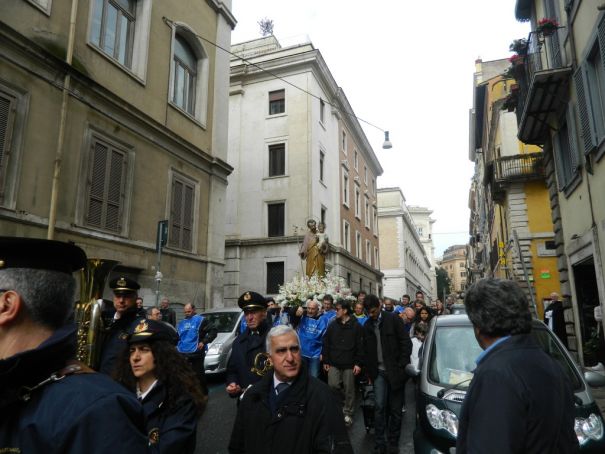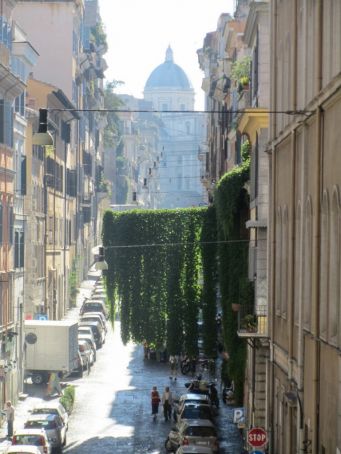Evviva S. Giuseppe! Each year local artisans and a religious order preserve the last remains of authentic Rome.
A group of men carry an altarpiece out of a church that stands between a hostel and a house. They are carrying the statue of St Joseph. A silent crowd follows them.
In front of the church, the owner of a boutique observes the crowd through a minimalist shop window while tourists watch curiously from a stylish coffee bar. Further down the street, the Indonesian owner of a cyber-café and a couple of Chinese hairdressers leave their shops and, in light rain, wonder what is going on.
Via Urbana, a cobbled street with patches of asphalt, lies in Rome’s first and oldest rione, Monti. The quarter is located halfway between the Colosseum and S. Maria Maggiore and houses goldsmiths as well as scrap dealers. And ever more boutiques.
The men who carry the altarpiece are all carpenters. They have their workshops on Via Urbana. It is quite common in their workshops to spot a traditional artefact, such as a sleigh from southern Italy in need of repair.
St Joseph is their patron. Every year the carpenters of Via Urbana honour their patron with a procession and a church ceremony. The Giuseppe Marello Order takes care of the S. Lorenzo di Fonte church. Next door, the order runs a hostel for pilgrims. The hostel displays a painting, a gift from the carpenter’s guild.
“Camminiamo sulla strada che han percorso i santi tuoi.” A priest from the Oblates of St Joseph heads the procession. He will take the crowd through Via dei Capocci, Via dei Serpenti, Via del Boschetto and Piazza degli Zingari. Over a microphone, he reads out biblical texts but also, following the pope’s recent declaration, condemns the Mafia.
Along the route, nuns sing religious songs and a brass band plays a slow-paced version of When the saints go marching in. A Mexican takes the microphone from her Nigerian sister – the Giuseppe Marello Order has missionary posts all over the world. Most of the older people in the procession know the lyrics by heart. Nobody seems to mind the rain.

Germán, a violin player from Santiago who is staying in the hostel, is in awe. “Such joyfulness and devotion,” he says. “They don’t do these things in Chile.”
The statue of St Joseph advances high above the crowd. On the upper floors, people gather at windows while others take pictures from the balcony. Below, in the streets, tourists look surprised: why isn’t this on the Ten Things To Do In Rome?
The Monti rione has always been a popular neighbourhood. Traditionally, it was home to working-class people who spoke their own dialect, monticiano. Having escaped from the fascists’ building appetite, and tucked away behind Via Cavour’s stately palazzi, Monti, with its network of alleys, is picturesque.
For months road works have paralysed traffic in Via Urbana. Meanwhile restaurants and bars have expanded their terraces and local stores have enjoyed a 30 per cent increase in turnover. A committee called Via Urbana pedonale organised a petition to pedestrianise the street and another committee, Via Urbana per Monti vivibile, organised a petition against the pedestrianisation. Store-owners and residents opposed each other. But the shopkeepers were not united: a message on the store of one pro-pedestrianisation committee member read: “You sold out!”
The Monti rione is falling victim to gentrification. In 2009, property prices in Monti were only one-third of those in Testaccio – like Trastevere, Rome’s textbook example of gentrification. Now Monti prices have surpassed those of Testaccio.
Slowly but surely new businesses are pushing out the traditional artisans. Though some of these new businesses harmonise with artisanship – a jazz music school, a film club – others do not. The prêt-à-porter of a boutique smothers the craft of a sartoria; the cold design of a franchise coffee shop damps the warmth of a torrefazione. Where a bakery once made delicious S. Giuseppe puff pastry there is now a sushi takeaway.
Monti’s new businesses refer to popular Rome: black and white images from Un americano a Roma decorate the walls and Eros Ramazzotti songs can be heard in the background of upscale bars and restaurants. Yet the population they refer to would not be able to afford the prices, and families who have lived in Monti for generations are being evicted or are leaving.
In early 2000 the owner of a building on Via degli Ibernesi – a street next to the Roman Forum and which features in the Hollywood movie To Rome With Love – informed his tenants that he would terminate their tenancies. Tenants started a fierce legal battle that would take years.
At the time, 10 families were living at Via degli Ibernesi 23, one of which comprised a 98-year old woman and her 61-year old son, while another included a severely disabled woman of 64.
Four years later, three families were evicted – tenants older than 65 benefitted from a six month delay. At the same time, the owners of Via del Boschetto 114 informed their tenants, 25 families, that they had 18 months to leave the building.
In 2006, the bailiffs evicted the last five families from Via degli Ibernesi 23.

Young carpenters take over the heavy altarpiece from the older ones. The march ends in front of the church of S. Lorenzo di Fonte. The brass band stops playing. With pride, the men carry in the altarpiece. Inside the church, the priest blesses everybody.
The S. Giuseppe procession may become a relic of the past when well-heeled foreigners with artistic ambitions and/or a romantic yearning meet business-savvy local residents. The new, well-off inhabitants – the kind of people who buy a lifestyle rather than a place to live – will complete the second wave of gentrification, the first being from bohemian to bourgeois, and in no time the area will host numerous B&Bs and there will be every possible accent of English.
Airbnb runs a website for people to rent out temporary accommodation. The avatars of people who advertise lodgings in Monti show swooning foreign females and matter-of-fact natives. They herald Monti’s “artsy and bohemian population”, “unmoneyed intelligentsia” and “invisible walls” that protect from the “adjacent tourist traps”. Airbnb's website features Via degli Ibernesi 23; a competitor website, bedandbreakfast.eu, advertises Via del Boschetto 114.
Meatpacking, Montmartre or Monti: despite these new businesses’ claim to authenticity, they are all alike. They transform neighbourhoods into nostalgia theme parks. Disney Roma SpA.
Even Via dei Capocci, one of the last strongholds, already boasts an airbrushed façade with the obligatory ivy, a carefully-placed flower pot and, of course, a video intercom.
Soon the carpenters will no longer discuss their work in front of their open workshops, nor will the older generation teach the younger the ropes. The bar next door will no longer offer them coffee, and neighbours will no longer stop by for a chat.
Yet the procession's followers include both the young and the old, male and female, religious and pagan, native and foreign. “This sense of unity,” says Massimo, a Genovese architect in Rome on business, “is what is needed to change the country.”
Evviva S. Giuseppe!
Mike Dilien
This article was first published in the April 2015 edition of Wanted in Rome magazine.

















